Estimated reading time: 5 minutes
Are you worried that your fruit trees might need some protection from frost? It might surprise you to learn that the important time to provide frost shelter for fruit trees is in spring, not in winter.
Fruit trees are actually pretty resilient against frosts in winter. In fact, frosts at that time of year can even do good by helping provide the chill hours your trees need.
Related Articles
Choosing the right fruit tree to plant
Choosing the right fruit trees to plant can make a huge difference to how much food you grow and the value you get from your garden.
Managing your fruit trees and frost
Learn about frost in your garden, how it may affect different types of fruit trees, and how to protect them by creating microclimates.
How can you get support for a community orchard?
Find out how to access resources and support to start a community orchard and build food security and resilience.
Many gardeners worry that yellow leaves on their trees have been caused by frost damage, but this is not usually the case. In fact, frost damage usually results in either black leaves, burnt tips, or damaged fruit.
Spring is the dangerous time. This is when a heavy frost can damage flowers, tiny fruit, or even drop-bears. The good news is that it’s perfectly possible to shelter your trees with a little thought and preparation.
So today we want to talk about a few different options for providing that shelter.
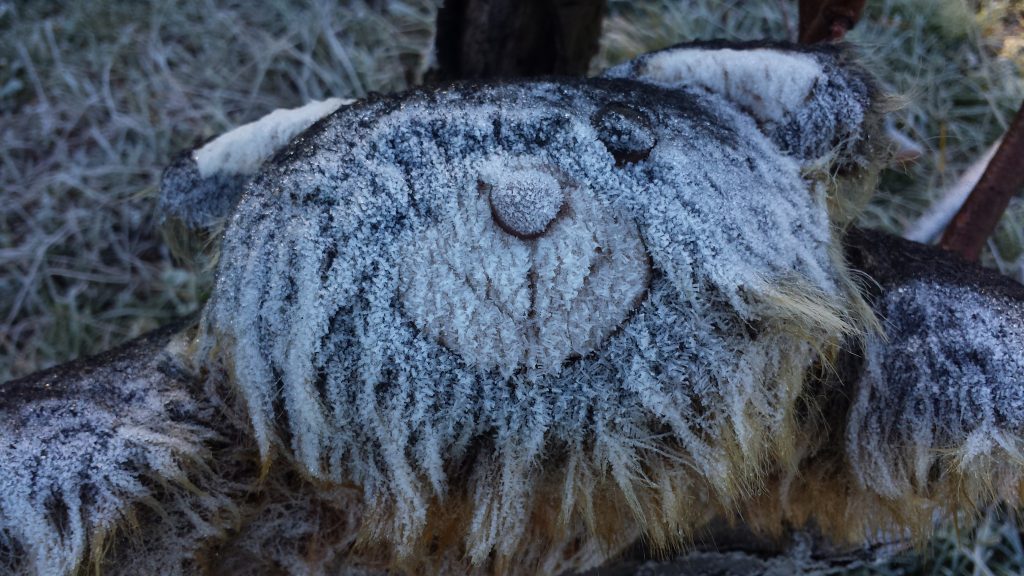
Infrastructure to provide frost shelter for your fruit tree
The first one is to build a frame over the tree. This is a great option, because you can use the same frame for bird netting, fruit fly netting, or frost cloth, depending on your need and the season.
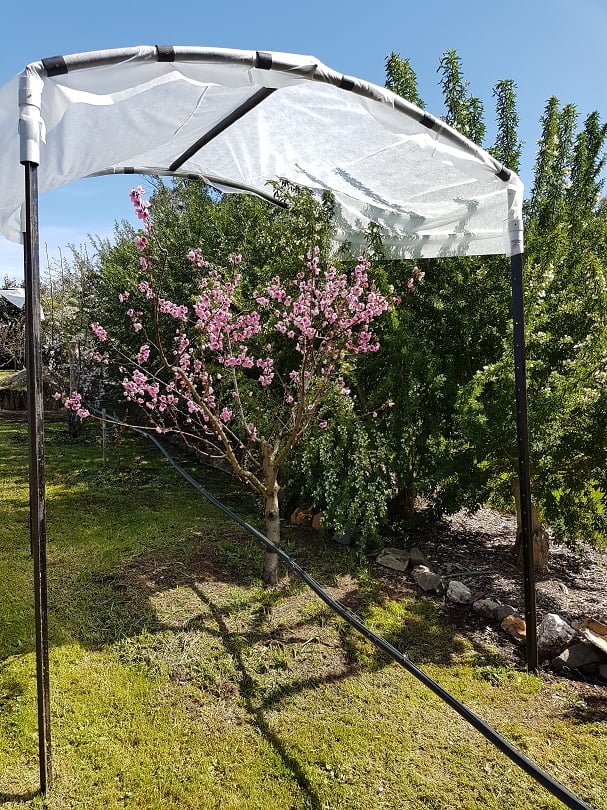
Frost cloth is a special, fine cloth that keeps the frost from settling on the ground. It’s great for protecting fruit trees, vegetables, or other precious crops.
Frost cloth is not very tough and it’s easy to work with. It’s even easy to sew with, as you can see in the photo below. This is the industrious Win (one of our Grow Great Fruit Home-study Program members) sewing the cloth to fit the frame.
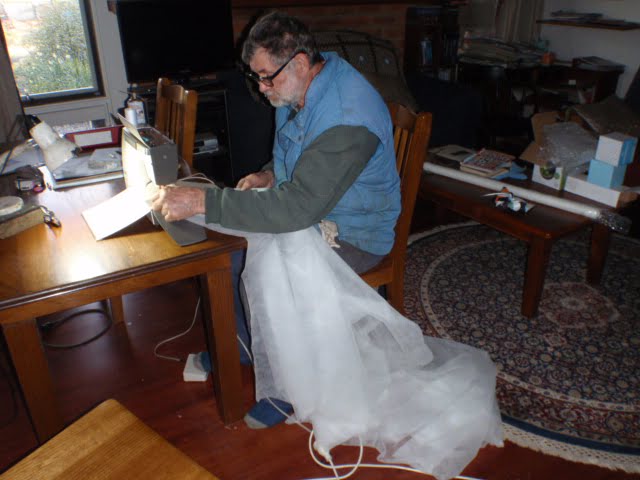
You can avoid the expense of frost cloth by using old sheets. However, a word of warning if you’re using a heavier cover and it completely covers the tree to the ground.
It’s best to put the cover on when a frost is forecast, and take it off again (or lift it up) mid-morning or when the frost has disappeared.
This is because a sheet can weigh the tree down unnecessarily and prevent sunlight and bees from getting to the tree.

Frost shelter from microclimates
Another way to provide the protection your trees need is to use assets you already have in the garden. In other words, make the most of existing microclimates.
Water tanks, buildings, and sheds can help provide shelter. Tall trees can provide quite a wide frost shadow, as you can see in the photo below.

However, you may not notice these micro-climates unless you go looking for them. Next time you have a big frost, get out in the garden early and check out your garden carefully.
Look carefully around for the influence of buildings, sheds, fences, water tanks, and other physical assets. Also notice how vegetation like trees, grass, and veggie patches determine where the frost lands, and how it flows in your garden.
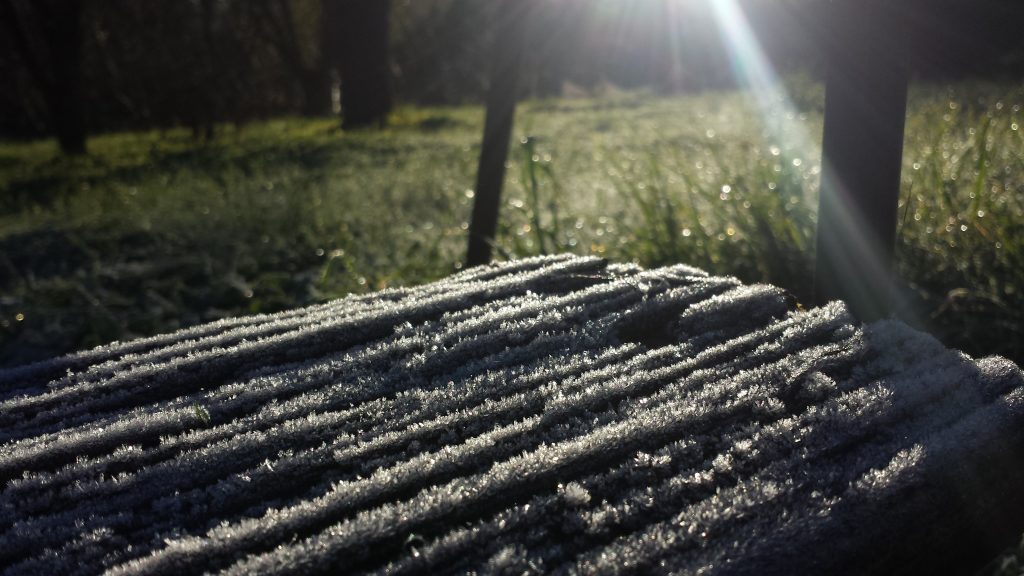
Other ways to provide shelter from frost
Other things you can do to protect your trees from frost include:
- putting sprinklers on your trees
- covering your fruit tree enclosure with frost cloth or similar
- using frost fans
- keeping your soil moist
- keeping the ground cover plants under your trees short, and
- refraining from using mulch, as it keeps the ground too cool.
Soil health helps with frost protection
Interestingly, all the things we recommend for soil health such as increasing the amount of organic matter in your soil can also make your plants more resistant to frost.
This is for two reasons:
- Healthy soil leads to plants with higher Brix levels, which have a lower freezing point;
- Soil with higher organic matter levels holds more moisture, which makes the plants less vulnerable to freezing.
Frost is definitely one of the factors you need to think about when planning your home orchard. However, with a little thought and care, it’s often possible to provide the protection your trees need.
Related Articles
Choosing the right fruit tree to plant
Choosing the right fruit trees to plant can make a huge difference to how much food you grow and the value you get from your garden.
Managing your fruit trees and frost
Learn about frost in your garden, how it may affect different types of fruit trees, and how to protect them by creating microclimates.
How can you get support for a community orchard?
Find out how to access resources and support to start a community orchard and build food security and resilience.



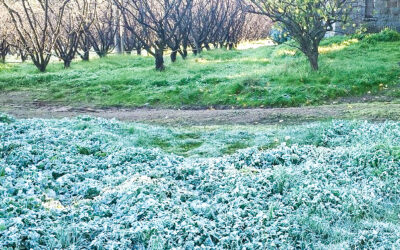



Concerned as a visit around my orchard ( 20 ish trees ) shows budding already on most of them?? Been a very warm Autumn here. Frosts abound here. Unsure if the frosts will kill the buds and if that means the trees may not produce more later??? Ideas. ? Info would be very welcomed!!!! Thanks so much!
Elle
That is concerning Elle – what region are you in? The buds will open up as either flowers, or leaves, and if there’s a bad frost when the tree is flowering they can get damaged. The bad news is that you only get one shot at it for the year, so it’s very important to protect the trees as much as you can during that vulnerable time.
I have around 70 mostly citrus trees in north Florida I lost about 15 last December to a 3 week freeze what’s the best way to avoid this
Katie, your photo above only has an awning over the top of the flowering tree. I guess it depends on the type of frosts you get if you also need to install frost cloth at the sides. My place has a nick name “ice cream valley” due to the frosts. I’m going to have to be mindful but the frost cloth over the top sides of fruit cage might be the solution!
Yes good point Kelly – frost comes from above, but also rolls down hills, so sides are definitely needed in some climates – as you’ve discovered!